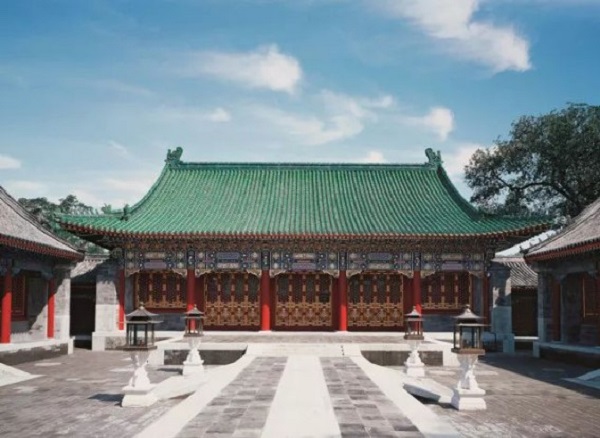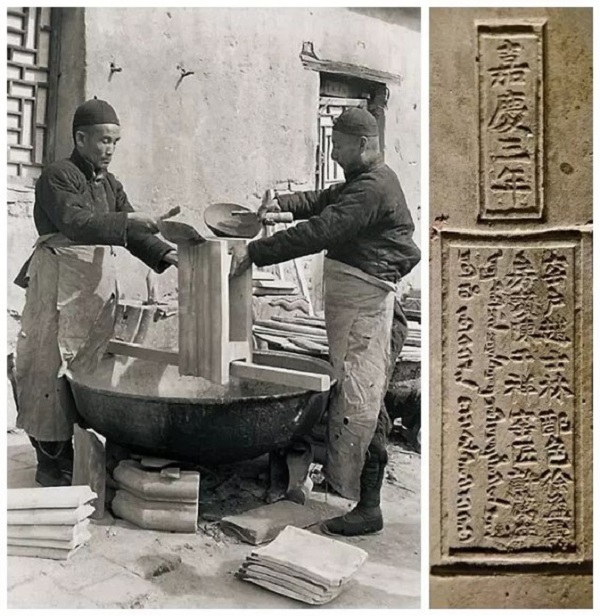
The snowy scenes in the magnificent Grand Viewing Garden (Daguanyuan in Chinese) of Jia Family in the well-known domestic novel Dream of the Red Chamber are fully reflected in the title of its 49th chapter, "White Snow and Red Plum Blossom in the Crystal World".
Many readers are deeply impressed by glazed tiles in emerald green, white snow and plum blossoms in the novel.

Plum trees blossom into flowers in Prince Kung's Palace
Prince Kung's Palace has a special bond with the novel since there are also eye-catching scenes formed by plum blossoms and white snow in winter. In addition, its glazed tiles have remained in their original color over the past two centuries.

Yin'an Hall in Prince Kung's Palace

Roof tiles on buildings in Prince Kung's Palace
Some people might ask: Why are roof tiles of buildings with ritual purposes along the central road in Prince Kung's Palace emerald green in color? In fact, there were strict rules in feudal China to select the colors of roof tiles in accordance with their social status.
For instance, glazed yellow tiles are reserved for royal palaces and ancestral halls of the royal family. City gates, the mansions of princes, temples and other religious institutes shall install green tiles on the roof of their buildings. The roof tiles of buildings for worship are generally blue, which is believed to be associated with the color of the sky.
In addition, black roof tiles were often used by low-rank officials and rich families.
Prince Kung's Palace belonged to He Shen (1750-1799), a top official during the reign of Emperor Qianlong (r. 1736-1795), before Emperor Xianfeng (r. 1851-1861) awarded it to Prince Kung (1833-1898) in 1851. Therefore, Prince Kung strictly followed the rules in the renovation of his new home.
Green roof tiles can only be found in four buildings along the central axis of Prince Kung's Palace. The main room of Yin'an Hall and Jiale Hall were built with green roof tiles, while those of their wing rooms were in grey. The sharp contrast of the colors of roof tiles in separate rooms has shown the implementation of conventional regulations and created additional charm for Prince Kung's Palace.
Some tourists might find that the colors of roof tiles on the front and rear slopes of these four buildings are slightly different. During its renovation, workers replaced broken roof tiles with those in the original color and pattern on the front slope, while new roof tiles were installed on the rear slope. It is thus very easy for visitors to discern these differences and experience historical changes.

A photo of roof tiles in different colors in Prince Kung's Palace
Of course, the selection of special colors in classical Chinese architecture is not only related to social status but also influenced by traditional Chinese culture of yin and yang, five elements and other conventional considerations in ancient times.
However, there are still some exceptions in the utilization of roof tiles in ancient buildings.
Wenyuan Ge, also known as the Pavilion of Literary Profundity, was used by emperors in the Ming and Qing dynasties to store their books in the Forbidden City. The color of its roof tiles is black, which is believed to prevent the occurrence of fire incidents in accordance with traditional Chinese culture of five elements.
The Hall of Prayer for Good Harvest, the main monument at the Temple of Heaven in Beijing, is another exception.
When making roof tiles, people generally mix stone with various metallic materials. Sun Tingquan (1613-1674), a high-ranking official in the early Qing Dynasty, recorded several raw materials used for the production of glazed tiles. A complex set of chemical reactions happens to metallic materials at high temperatures, leading to the formation of rich colors of tiles. For instance, yellow glazed tiles will be produced with ferric oxide.
To better control the color and composition of glazed tiles, their raw materials have to undergo over 20 procedures, which include smashing, washing, coloring and drying. It often takes dozens of days to accomplish each step in the making of glazed tiles. The manufacturing of roof tiles generally takes place in government-owned kilns and those belonging to individuals. All high-level glazed tiles are expected to be burnt twice. Technical workers will place their rudimentary products into a kiln for molding before coloring and drying them for the second time burning. It is their craftsmanship that has preserved the original charm and greatness of roof tiles in ancient Chinese architecture.

Two technical workers make glazed tiles in ancient China.